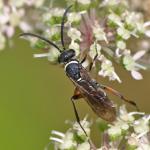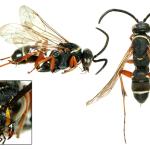The distribution of Ceropales maculata seems to have a south-western bias with former strongholds in Cornwall, Devon and Dorset, although there are no records for the east Devon heaths (perhaps due to a low level of recording). Outside this area it is found along the west coast with scattered records inland. Recent Scottish records are from the shores of the Firth of Clyde and the Moray Firth; the Speyside records are all pre-1951. In Ireland the species is widespread, with a largely coastal distribution. Ceropales maculata appears to have undergone a dramatic decline during the second half of this century in many areas, although the Welsh populations still seem to be strong.
It is widely distributed across the Palaearctic from Europe and North Africa eastwards to Japan.
This species is not listed in either Shirt (1987) or Falk (1991): however, work for this Atlas suggests that its status should be reviewed.
Day (1988) is the standard work for identifying British Pompilidae. Wiśniowski (2009) is also useful.
Sand pits, heaths and coastal dunes.
Univoltine; May to September.
The genus Ceropales is unique in its approach to providing for its offspring. Females seek out female pompilids of other genera which are transporting their paralysed prey. The host female is driven off and the Ceropales female uses her highly modified abdomen to insert her egg into the lung-book of the paralysed spider. The prey is then abandoned and the host female usually returns to complete the process of dragging it back to its nest site, unaware of the egg hidden in the spider. The Ceropales egg hatches first in the completed brood cell and the larva immediately seeks out and consumes the egg of the host. It then feeds on the spider and develops normally (Day, 1988). Species in the genera Priocnemis, Pompilus, Agenioideus, Arachnospila, Anoplius, Episyron and Auplopus have all been reported as hosts to C. maculata in Britain and Europe. Other species which use spiders as prey, such as Miscophus (Crabronidae), may also be parasitised.
Wild carrot.
No information available.
1998



